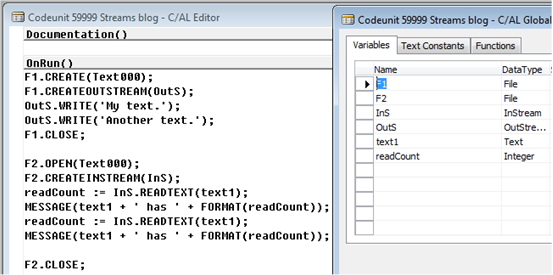The asymmetric stream
Since NAV’s Stream introduction, there has been confusion about when to use READ and when to use READTEXT; when to use WRITE and when WRITEXT.
As it is documented, InStream.READ and OutStream.WRITE are meant to be in binary format, which means that Text strings will be ‘zero terminated’ when written, and a ‘zero terminated’ is expected when you are using READ; however READTEXT will not expect a ‘zero terminated’ text, but can accept one.
This very last feature makes the streams asymmetric, as you can write different binary formats than what you can read.
Take the following code snippet:

If we examine the file that gets created (in a binary text editor), you will notice that the Texts are in fact ‘zero terminated’, but the READTEXT will be able to read them individually.
Now, this is where the fun begins. We can change the READTEXT to be READ (as it should have been) and everything will continue to work exactly the same…, almost. You will notice that the readCount now (when using InS.READ) will include the zero termination, whereas before the count was only for the characters in the text. Actually, if you put a return value in the WRITE (char 13), you will notice that the zero termination is included in the count (because actually that was the binary format of the Text).
So, count in count := OutS.WRITE('My text.'); will be 9 (8 characters and a zero termination), whereas count := OutS.WRITETEXT('My text.'); will be 8. The reason why it was decided to return the written bytes, was precisely so that people would know how many bytes are sent through the Stream.
Another thing to take in consideration when working with Streams are CODE types. When writing CODE types using OutStream.Write, they are NOT written in NAV binary format. So they are not symmetric with the FILE.WRITE function; however, InStream.READ(CodeType) will accept either data written using OutStream.WRITE(CodeType), or FILE.WRITE(CodeType).
Another possibility is to write data using OutStream.WRITETEXT(Text) and read it via InStream.READ(Text). Just take in consideration that when using OutStream.WRITE(Text), the Text will be zero terminated and when using OutStream.WRITETEXT(Text), it will not.
Jorge Alberto Torres
Software Developer Engineer
These postings are provided "AS IS" with no warranties and confer no rights. You assume all risk for your use.